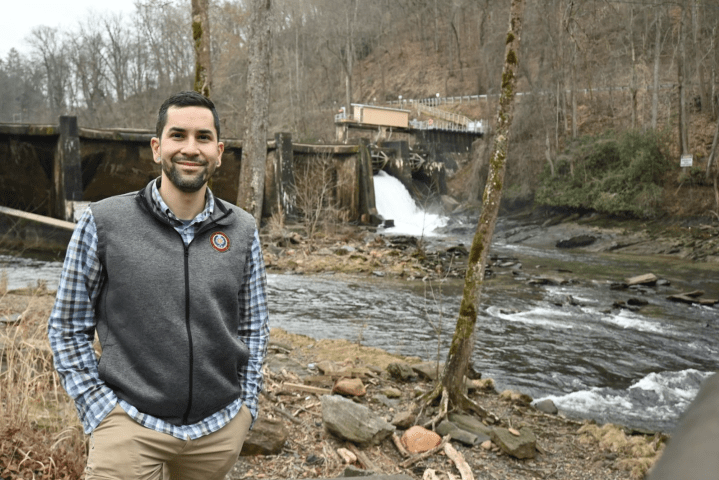
Removing a dam, reconnecting communities

Dozens of dams are removed nationwide every year, some because they’ve fallen into disrepair and others to restore rivers and wildlife habitats. In North Carolina, conservation and environmental groups and the Eastern Band of Cherokee Indians want to remove a small dam that’s nearly a century old. But that hinges on getting millions of dollars in federal funding.
The Ela Dam opened in 1925 across the Oconaluftee River in Swain County, on the Tennessee border. Upstream, the river and its tributaries flow through the land of the Eastern Band of Cherokee Indians.
“Ela Dam has disconnected our entire watershed and our tribal lands for nearly a century,” said Joey Owle, the tribe’s secretary of agriculture and natural resources.
Owle said removing the dam would let aquatic species return to Cherokee lands. Some are endangered or at risk, like a fish called the sicklefin redhorse that was once an important food source; the eastern hellbender, one of the world’s largest salamanders; and the Appalachian elktoe, a freshwater mussel.
“What we aim to do is really bring back the natural processes of the various species, aquatic relatives, on this landscape here,” Owle said. “This dam has served its purpose … let’s get back to restoring nature as it was.”
The tribe hopes to do that with the help of American Rivers, a national group that specializes in river restoration. The organization is a partner in the proposed Ela Dam removal project.
“The best way to restore a stream is by removing a dam,” said American Rivers biologist Erin McCombs. She said the project would reinstate fish, mussels and other creatures upstream.
The Cherokees have pushed for removal for years — without success. That changed in 2021, when the dam’s gates opened unexpectedly, sending 8,000 tons of sediment downriver. After that, Owle called the president of the dam’s owner, Northbrook Carolina Hydro, and asked: Can this dam be removed?
“And to my own surprise, they’re like, ‘Yeah, let’s get a conversation on this, bring some partners to the table,'” Owle said.
Within weeks, the Cherokees, American Rivers, the local Mainspring Conservation Trust and other groups had an agreement.
Northbrook’s Curt Whittaker manages the dam. He said that given its small size and the potential cost of more repairs or spills, the deal made sense.
“We spent money, we tried to do the right thing, and the river is in good shape. And it’s nothing that we ever want to go through again,” Whittaker said.
Northbrook plans to donate the dam to the Cherokees and their partners. The tribe has asked the U.S. Fish and Wildlife Service for $10 million from the 2021 federal infrastructure law to remove it. The project fits the law’s intent, said Tim Gestwicki of the North Carolina Wildlife Federation.
“So the money is there. We hope and pray that we won’t miss this opportunity,” he said.
A decision on funding is expected by June. Permitting and removal could take three years.
There’s a lot happening in the world. Through it all, Marketplace is here for you.
You rely on Marketplace to break down the world’s events and tell you how it affects you in a fact-based, approachable way. We rely on your financial support to keep making that possible.
Your donation today powers the independent journalism that you rely on. For just $5/month, you can help sustain Marketplace so we can keep reporting on the things that matter to you.













